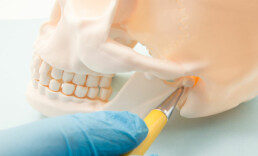Here’s a topic worth jawing about: temporomandibular joint disorder, or TMJ disorder (TMD), a facial joint disorder that is painful, rather than fatal; however, it can be uncomfortable.
When people who suffer from TMD open their jaws, the movement may provide “musical” accompaniment in the form of clicks or popping sounds that they are unable to prevent. But what is TMJ?
TMJ Disorder (TMD)
The temporomandibular joints are the joints connecting the temporal bones of the skull to the mandible, or jaw bone, hence the name. It is commonly referred to as the TMJ. There is one on each side of our heads.
These joints, which are lined by cartilage and contain a fibrogelatinous disc between the bones, open and close like hinges. They allow the jaw to move both up and down and side to side, making them among the most complicated of the body’s joints.
A TMJ disorder refers to problems with the jaw joints, muscles or fibrous tissues that connect them. TMJ disorders are most prevalent among women in their early 20s or during their 40s and 50s, while undergoing menopause. Men are affected by TMD less frequently.
TMJ Symptoms
Common TMJ symptoms include:
- Pain. Pain while moving the jaw is an obvious symptom of TMJ disorder, but the disorder may also cause headaches or migraines, earaches, neck aches and back aches. The earaches may be accompanied by ringing or buzzing your ears. Your chewing muscles will generally be tender and painful when touched.
- Minimal movement. Limited movement may prevent you from fully opening your mouth or from moving your jaw in particular directions. For example, non-sufferers can generally hold their index, middle and ring fingers horizontally and insert them easily between the upper and lower teeth. People with TMJ disorders will generally find it difficult to open their mouths so wide.
- Noise pollution. TMJ disorders are often accompanied by sounds that occur when you talk, eat or open your mouth. The noises may be clicking, popping or grinding sounds and will be present concurrently with the pain or restricted movement. If the noises are not linked to one of the other symptoms, they are generally harmless.

Diagnosis
A TMJ disorder will generally be diagnosed by a doctor or a dentist based on a physical examination in combination with a review of the patient’s medical history. Depending on the outcome, a magnetic resonance imaging (MRI) test for your disc, an X-Ray of your teeth or a Computed Tomography (CT) scan of your bones may be required.
What Is the Best Treatment for TMJ?
You may be able to treat mild or moderate TMJ disorder at home by making lifestyle changes. TMJ home treatment may involve a reduction in joint movements and more rest for the jaw by avoiding chewing gum and tensing the jaw and by eating only soft foods. The application of ice or moist heat may also be useful, along with non-steroidal anti-inflammatory drugs.
Reducing stress in your life may also be helpful; yoga and meditation are often good ways to alleviate stress, and counselling (therapy) can be useful, too. You may also wish to try biofeedback or acupuncture to help relieve pain.
Is There Physical Therapy for TMJ?
A visit to your physiotherapist is recommended if symptoms are not relieved with home treatment and are related to muscle tension. Your physiotherapist can prescribe a program for you that includes learning and practicing techniques for regaining normal jaw movement.
TMJ exercises may relieve pain, reduce tension and strengthen the jaw area in order to prevent future flare-ups. Your physiotherapist will be able to recommend an appropriate series of exercises that begins with massaging the area to reduce tension and pain. You’ll move on to relaxation, strengthening and stretching exercises. They may also use ultrasound treatments.
If none of these approaches proves effective, your physician or dentist may suggest a corticosteroid injection, arthroscopy or open joint surgery.
Remember: pain is your body’s signal that something isn’t right. If your jaw begins to ache regularly, don’t ignore the feeling. The sooner you obtain treatment, the sooner you’ll feel like yourself again.
